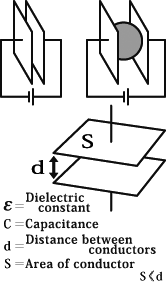Dictionary of Capacitance Terms
Capacitance? Dielectric constant?
It may sound unfamiliar, but our products are meant to measure it.
The devices required to measure capacitance are metal electrodes and a converter that converts the capacitance obtained from the electrodes into electrical signals.
Electrodes have different shapes, structures, and materials depending on the purpose of use, and experience and achievements are required for manufacturing, installation, and adjustment.
Converter must meet more diverse needs than electrodes, and require experience, achievements, and advanced technology.
Let me briefly explain capacitance and dielectric constant.
Capacitance
When two conductors, ground and detection, are in air, an electrical charge builds up between them. Capacitance is a value that indicates that accumulation force.If we compare it to water, it is the storage capacity of how much can be stored at a given water level.
Capacitance depends on the shape of the two conductors, the distance between them, and the nature of the space in which they are placed.If the volume of the conductor is halved, the capacitance is also halved, and if the volume is doubled, the capacitance is doubled.
Capacitance for simple conductor shapes and materials can be obtained using formulas.
![]() The following formula can be used for the two metal parallel plates shown on the right.
The following formula can be used for the two metal parallel plates shown on the right.
In reality, it is difficult to determine the capacitance by calculation, because in most cases it is not as simple as shown in the figure on the right. So, You should use a capacitance meter.

Dielectric constant
Inserting an insulator between two conductors increases the capacitance.When the original capacitance is Co and the increased capacitance is C, the ratio of C to Co (C/Co) is the relative permittivity (εs) of the material.This is inherent in all matter. So by measuring the relative permittivity, we can infer the state of matter.
Explain physical phenomena related to dielectric constant.Insulators cannot conduct electricity because there are no free electrons (electrons that can move freely within the metal).When an insulator is placed in an electric field, a phenomenon called electronic polarization occurs, which is expressed as a change in capacitance. From the change, the relative permittivity can be calculated.
The relative permittivity of major materials is summarized in the table.
The dielectric constant of vacuum (εo) is intended to be consistent with other units in the Sl unit system. If the magnetic permeability of the vacuum is μo, the dielectric constant of the vacuum is εo, and the speed of light is C, they are εoμo = 1/C².
The magnetic permeability of a vacuum is μo = 4π × 10-⁷H/m and the dielectric constant is εo = 1/μoC² = 8.854 × 10-¹²F/m.
Dielectric constant of vacuum εo, relative permittivity εs, dielectric constant ε. ε = εoεs.
ε and εs are sometimes confused, but in most cases this is not a problem.